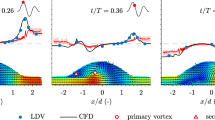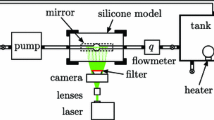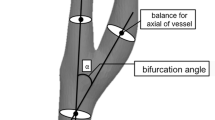Abstract
Purpose
To assess reliability of wall shear stress (WSS) calculations using computational fluid dynamics (CFD) dependent on inflow in internal carotid artery aneurysms (ICA).
Materials and methods
Six unruptured ICA aneurysms were studied. 3D computational meshes were created from 3D digital subtraction angiographic images (Axiom Artis dBA, Siemens Medical Solutions). Transient CFD simulations (Fluent, ANSYS Inc.) were performed for two inflow conditions: (1) idealized averaged waveform from normal subjects (ID) and (2) patient-specific waveform (PS) measured with 2D phase contrast magnetic resonance imaging. Stability of calculation was assessed by comparing mean WSS (<WSS>), temporal wall shear stress magnitude variation (ΔWSS), and oscillatory shear index (OSI, a measure of variation in the WSS direction) on the aneurysmal wall for both conditions.
Results
For all cases, mean relative difference (PS−ID) of WSS (<WSS>) was −15% (range −32% to 11%). Mean ΔWSS difference was −29.3% ( −100% to 67%). Mean OSI difference was 7.5% (−12% to 40%). Large variations in histograms of these parameters were noted.
Conclusion
For accurate calculations of WSS parameters, patient-specific information on physiological flow may be necessary. Results obtained with averaged or idealized flow waveforms may have to be interpreted with caution.

Similar content being viewed by others
References
Acevedo-Bolton G, Jou LD, Dispensa BP, Lawton MT, Higashida RT, Martin AJ, Young WL, Saloner D (2006) Estimating the hemodynamic impact of interventional treatments of aneurysms: numerical simulation with experimental validation: technical case report. Neurosurgery 59:E429–E430, author reply E429–430
Castro MA, Putman CM, Cebral JR (2006) Computational fluid dynamics modeling of intracranial aneurysms: effects of parent artery segmentation on intra-aneurysmal hemodynamics. AJNR Am J Neuroradiol 27:1703–1709
Castro MA, Putman CM, Cebral JR (2006) Patient-specific computational fluid dynamics modeling of anterior communicating artery aneurysms: a study of the sensitivity of intra-aneurysmal flow patterns to flow conditions in the carotid arteries. AJNR Am J Neuroradiol 27:2061–2068
Castro MA, Putman CM, Cebral JR (2006) Patient-specific computational modeling of cerebral aneurysms with multiple avenues of flow from 3D rotational angiography images. Acad Radiol 13:811–821
Cebral JR, Castro MA, Burgess JE, Pergolizzi RS, Sheridan MJ, Putman CM (2005) Characterization of cerebral aneurysms for assessing risk of rupture by using patient-specific computational hemodynamics models. AJNR Am J Neuroradiol 26:2550–2559
Cebral JR, Lohner R (2005) Efficient simulation of blood flow past complex endovascular devices using an adaptive embedding technique. IEEE Trans Med Imaging 24:468–476
Cebral JR, Pergolizzi RS Jr, Putman CM (2007) Computational fluid dynamics modeling of intracranial aneurysms: qualitative comparison with cerebral angiography. Acad Radiol 14:804–813
Dempere-Marco L, Oubel E, Castro M, Putman C, Frangi A, Cebral J (2006) CFD analysis incorporating the influence of wall motion: application to intracranial aneurysms. Med Image Comput Comput Assist Interv Int Conf Med Image Comput Comput Assist Interv 9:438–445
Ford MD, Alperin N, Lee SH, Holdsworth DW, Steinman DA (2005) Characterization of volumetric flow rate waveforms in the normal internal carotid and vertebral arteries. Physiol Meas 26:477–488
Ford MD, Lee SW, Lownie SP, Holdsworth DW, Steinman DA (2008) On the effect of parent-aneurysm angle on flow patterns in basilar tip aneurysms: towards a surrogate geometric marker of intra-aneurismal hemodynamics. J Biomech 41:241–248
Ford MD, Nikolov HN, Milner JS, Lownie SP, Demont EM, Kalata W, Loth F, Holdsworth DW, Steinman DA (2008) PIV-measured versus CFD-predicted flow dynamics in anatomically realistic cerebral aneurysm models. J Biomech Eng 130:021015
Ford MD, Stuhne GR, Nikolov HN, Habets DF, Lownie SP, Holdsworth DW, Steinman DA (2005) Virtual angiography for visualization and validation of computational models of aneurysm hemodynamics. IEEE Trans Med Imaging 24:1586–1592
Funamoto K, Hayase T, Saijo Y, Yambe T (2008) Numerical experiment for ultrasonic-measurement-integrated simulation of three-dimensional unsteady blood flow. Ann Biomed Eng
He XJ, Ku DN (1996) Pulsatile flow in the human left coronary artery bifurcation: average conditions. Journal of Biomechanical Engineering-Transactions of the Asme 118:74–82
Hecht N, Woitzik J, Dreier JP, Vajkoczy P (2009) Intraoperative monitoring of cerebral blood flow by laser speckle contrast analysis. Neurosurg Focus 27:E11
Hoi Y, Woodward SH, Kim M, Taulbee DB, Meng H (2006) Validation of CFD simulations of cerebral aneurysms with implication of geometric variations. J Biomech Eng 128:844–851
Imai Y, Sato K, Ishikawa T, Yamaguchi T (2008) Inflow into saccular cerebral aneurysms at arterial bends. Ann Biomed Eng 36(9):1489–1495
Jou LD, Lee DH, Morsi H, Mawad ME (2008) Wall shear stress on ruptured and unruptured intracranial aneurysms at the internal carotid artery. AJNR Am J Neuroradiol 29:1761–1767
Jou LD, Mawad ME (2009) Growth rate and rupture rate of unruptured intracranial aneurysms: a population approach. Biomed Eng Online 8:11
Jou LD, Wong G, Dispensa B, Lawton MT, Higashida RT, Young WL, Saloner D (2005) Correlation between lumenal geometry changes and hemodynamics in fusiform intracranial aneurysms. AJNR Am J Neuroradiol 26:2357–2363
Karmonik C, Benndorf G, Klucznik R, Haykal H, Strother CM (2006) Wall shear stress variations in basilar tip aneurysms investigated with computational fluid dynamics. Conf Proc IEEE Eng Med Biol Soc 1:3214–3217
Karmonik C, Klucznik R, Benndorf G (2008) Blood flow in cerebral aneurysms: comparison of phase contrast magnetic resonance and computational fluid dynamics—preliminary experience. Rofo 180:209–215
Karmonik C, Klucznik R, Benndorf G (2008) Comparison of velocity patterns in an AComA aneurysm measured with 2D phase contrast MRI and simulated with CFD. Technol Health Care 16:119–128
Karmonik C, Yen C, Grossman RG, Klucznik R, Benndorf G (2009) Intra-aneurysmal flow patterns and wall shear stresses calculated with computational flow dynamics in an anterior communicating artery aneurysm depend on knowledge of patient-specific inflow rates. Acta Neurochir (Wien) 151(5):479–485
Kim M, Taulbee DB, Tremmel M, Meng H (2008) Comparison of two stents in modifying cerebral aneurysm hemodynamics. Ann Biomed Eng 36:726–741
Liou TM, Li YC, Juan WC (2007) Numerical and experimental studies on pulsatile flow in aneurysms arising laterally from a curved parent vessel at various angles. J Biomech 40:1268–1275
Malek AM, Izumo S (1995) Control of endothelial cell gene expression by flow. J Biomech 28:1515–1528
Mantha A, Karmonik C, Benndorf G, Strother C, Metcalfe R (2006) Hemodynamics in a cerebral artery before and after the formation of an aneurysm. AJNR Am J Neuroradiol 27:1113–1118
Meng H, Wang Z, Kim M, Ecker RD, Hopkins LN (2006) Saccular aneurysms on straight and curved vessels are subject to different hemodynamics: implications of intravascular stenting. AJNR Am J Neuroradiol 27:1861–1865
Mitsos AP, Kakalis NM, Ventikos YP, Byrne JV (2008) Haemodynamic simulation of aneurysm coiling in an anatomically accurate computational fluid dynamics model: technical note. Neuroradiology 50:341–347
Ortega J, Hartman J, Rodriguez J, Maitland D (2008) Post-treatment hemodynamics of a basilar aneurysm and bifurcation. Ann Biomed Eng 36(9):1531–1546
Radaelli AG, Augsburger L, Cebral JR, Ohta M, Rufenacht DA, Balossino R, Benndorf G, Hose DR, Marzo A, Metcalfe R, Mortier P, Mut F, Reymond P, Socci L, Verhegghe B, Frangi AF (2008) Reproducibility of haemodynamical simulations in a subject-specific stented aneurysm model—a report on the Virtual Intracranial Stenting Challenge 2007. J Biomech 41:2069–2081
Sato K, Imai Y, Ishikawa T, Matsuki N, Yamaguchi T (2008) The importance of parent artery geometry in intra-aneurysmal hemodynamics. Med Eng Phys 30:774–782
Sforza DM, Putman CM, Cebral JR (2009) Hemodynamics of cerebral aneurysms. Annu Rev Fluid Mech 41:91–107
Shimogonya Y, Ishikawa T, Imai Y, Matsuki N, Yamaguchi T (2009) Can temporal fluctuation in spatial wall shear stress gradient initiate a cerebral aneurysm? A proposed novel hemodynamic index, the gradient oscillatory number (GON). J Biomech 42:550–554
Valencia A, Morales H, Rivera R, Bravo E, Galvez M (2007) Blood flow dynamics in patient-specific cerebral aneurysm models: the relationship between wall shear stress and aneurysm area index. Med Eng Phys 30(3):329–340
Venugopal P, Valentino D, Schmitt H, Villablanca JP, Vinuela F, Duckwiler G (2007) Sensitivity of patient-specific numerical simulation of cerebal aneurysm hemodynamics to inflow boundary conditions. J Neurosurg 106:1051–1060
Zhao M, Amin-Hanjani S, Ruland S, Curcio AP, Ostergren L, Charbel FT (2007) Regional cerebral blood flow using quantitative MR angiography. AJNR Am J Neuroradiol 28:1470–1473
Zhao M, Charbel FT, Alperin N, Loth F, Clark ME (2000) Improved phase-contrast flow quantification by three-dimensional vessel localization. Magn Reson Imaging 18:697–706
Author information
Authors and Affiliations
Corresponding author
Additional information
Comment
How to identify intracranial aneurysms at risk of rupture from those that never will rupture, remains a significant clinical challenge that has very drastic implications for the life of patients with aneurysms. Recent studies of the pathobiology of the aneurysm wall, as well as the emerging field of computational hemodynamic models, have tried to develop a reliable solution for the prediction of rupture-risk.
As with all simulations and mathematical models, the main question regarding their usefulness for clinical applications is how accurately they represent the reality. In the field of computational fluid dynamics, it has been well known that the models are as accurate as their input parameters – e.g. the geometry of the vasculature and of the aneurysm, the flow conditions, and the other boundary conditions. Because accurate, non-invasive measurements for some of these parameters are difficult – especially for the inflow velocities and vectors – there is a strong urge to simplify the computational models by making generalizations and assumptions for those parameters that are too difficult to actually measure.
The study by Karmonik et al. elegantly demonstrates how important it is to have accurate, patient specific boundary conditions for the computational fluid dynamic models. Otherwise you will end up with a very elegant appearing model that has little to do with the real distribution and intensity of mechanical stress in the aneurysm, and hence might easily mislead in the clinical decision making of which aneurysm to operate, when, and what site of the aneurysm should be especially well occluded.
Juhana Frösen
Mika Niemelä
Juha Hernesniemi
Helsinki, Finland
The authors have no financial relationships to disclose.
Rights and permissions
About this article
Cite this article
Karmonik, C., Yen, C., Diaz, O. et al. Temporal variations of wall shear stress parameters in intracranial aneurysms—importance of patient-specific inflow waveforms for CFD calculations. Acta Neurochir 152, 1391–1398 (2010). https://doi.org/10.1007/s00701-010-0647-0
Received:
Accepted:
Published:
Issue Date:
DOI: https://doi.org/10.1007/s00701-010-0647-0




